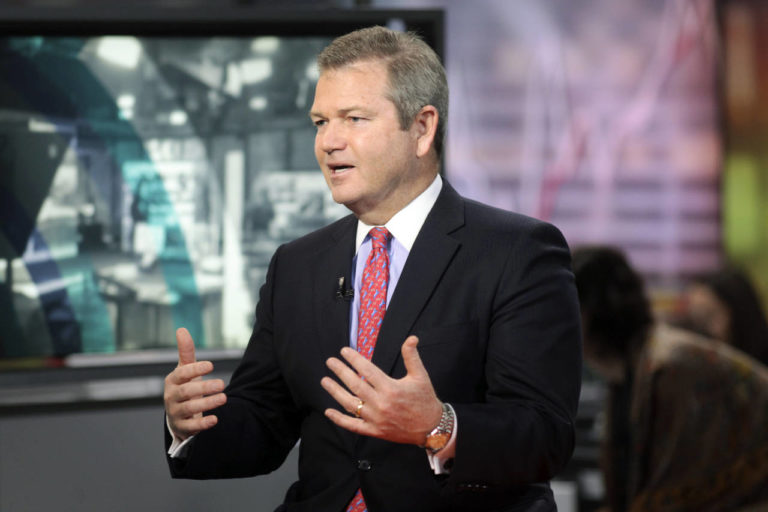

U.S. stocks are down 5% from their Jan. 26 peak, while shares of Invesco have fallen much more, about 15%. That’s a buying opportunity. Like any mutual fund company, Invesco earns fees tied to the value of the assets it manages, so in the near term, it will probably make less if stocks go into a prolonged dive. But perhaps more than any mutual fund company, Invesco could be a long-term beneficiary of the next bear market.
One reason is that a downturn might help Invesco (ticker: IVZ) step out of the shadow of industry titan BlackRock (BLK) by displaying the value of Invesco’s bread-and-butter strategy: factor investing. Another is that, in the past, Invesco has shown a knack for snapping up weaker players during industry downturns.
“During the Great Recession, we were in a strong enough position to buy Van Kampen mutual funds from Morgan Stanley [MS] and a real estate business from American International Group [AIG],” says Invesco’s chief executive, Martin Flanagan. “We’ll be ready again when the next recession hits.”
THE PRICE IS ALLURING, TOO. At a recent 10.7 times projected earnings for the next four quarters, Invesco stock is among the cheapest in the asset-management universe. It trades at a 44% discount to BlackRock, relative to earnings, versus an average discount of 19% over the past decade.
That makes a return of more than 20% for Invesco stock over the coming year look plenty feasible. It was recently upgraded by analysts at Deutsche Bank and Credit Suisse, who predict gains of 18% and 30%, respectively, from a recent $32.21. The dividend yield is 3.6%.
Atlanta-based Invesco manages $938 billion and is perhaps best known for its PowerShares family of exchange-traded funds, the fourth-largest in the business, behind BlackRock, Vanguard Group, and State Street (STT). As Barron’s reported last month, PowerShares will be rebranded as Invesco sometime this year. So will Guggenheim ETFs in the U.S. and Source ETFs in the U.K., two 2017 acquisitions.
Invesco has nearly twice as much exposure to stocks as to bonds; more than twice as much retail exposure as institutional; and much more business in the U.S. than overseas. Almost 80% of the money it manages is in active strategies, rather than passive ones.
This last point would seem to present a headwind. Over the past decade, investors have flocked to passive funds with ultra-low fees, like the iShares Core S&P 500 ETF (IVV), which costs just 0.04% a year. That has been a boon for BlackRock, which manages more than $6 trillion. Its shares have returned 86%, versus 44% for the S&P 500, since Barron’s recommended them 2½ years ago (“Why BlackRock Is a Buy,” Aug. 22, 2015).

Active managers, meanwhile, have struggled with customers withdrawing funds, although that has been offset, until recently, by a broad rise in the market value of assets. Franklin Resources (BEN), for example, has seen net outflows for three straight years.
Invesco has fared better than most. Net flows have sometimes flipped back and forth from positive to negative from month to month, but have ended up positive in each of the past three years. Solid investment performance has helped. Some 64% of Invesco’s actively managed assets have outpaced their peers over the past three years; 75% over the past five years.
What makes Invesco unique is its outsize exposure to factor investing, used for $210 billion of its assets. Factor strategies, sometimes called smart beta or fundamental indexing, fall somewhere between passive and active investing, typically weighting stocks by attributes that have been shown to predict healthy performance. For example, the PowerShares FTSE RAFI US 1000 Portfolio (PRF) weights companies by cash flow, book value, sales and dividends, rather than the market valuation of their shares. Expenses are 0.39% a year. The fund’s approach gives it a value tilt (although its creators might argue instead that the S&P 500 has a non-value tilt). Only one of its top five holdings, Apple (AAPL), is in tech. For the iShares Core S&P 500, the number is five out of five, including Alphabet (GOOGL), Amazon.com (AMZN), Microsoft (MSFT), and Facebook (FB).
THE FUND HAS BEATEN the S&P 500, after fees, over the past decade, but not by enough to draw much attention. What will be telling, however, is how it performs during the next bear market. “There’s a role for cap-weighted indexes, but money has been going disproportionately into stocks that are up the most,” says Flanagan. “It’s a momentum trade, and investors could get hurt in the next downturn.”
If Flanagan is right, the next bear market could help prove the worth of factor investing, boosting Invesco’s flows during the bull market that follows. In the near term, there are other promising signs. With bond yields up recently, Bank of America Merrill Lynch screened for stocks that in past decades have outperformed during months when yields rose, and Invesco was one name that turned up. Invesco stock is even cheaper than Franklin’s, despite Invesco’s better flows and lower exposure to bonds.
Wall Street expects Invesco to grow its earnings per share by double-digit percentages this year and next. That outlook, the low valuation, and the nice dividend yield should attract bargain hunters.